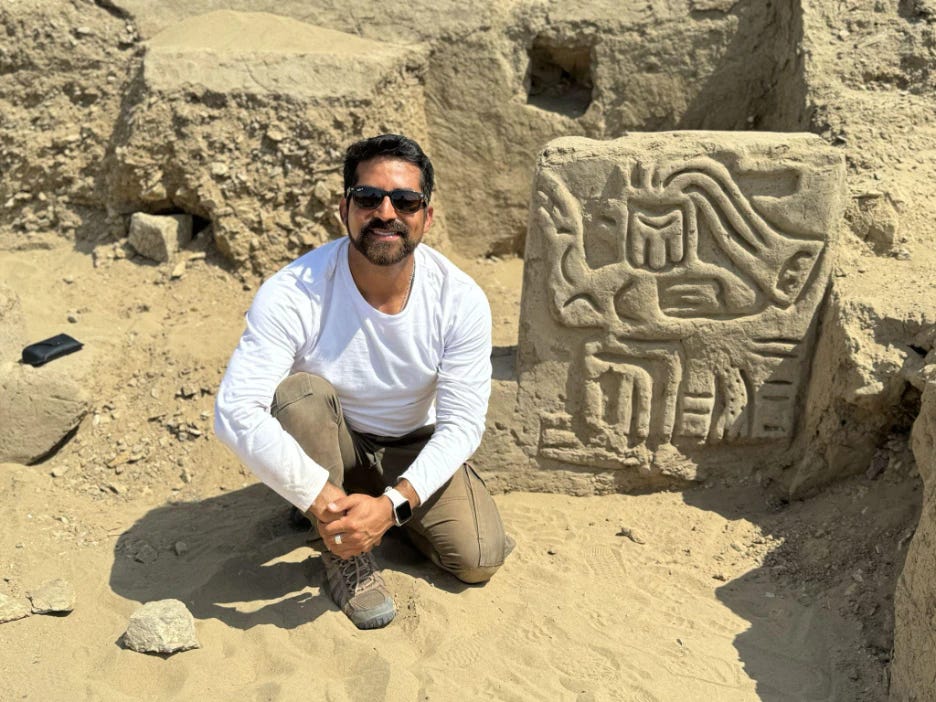Discovery of a 4,000-Year-Old Ceremonial Temple in Peru
Manage episode 429010801 series 3444207
Archaeologists in Peru have made a groundbreaking discovery1: the remains of a 4,000-year-old temple and theater. This finding promises to significantly enhance our understanding of ancient religious practices and social structures in the Andes.

Ancient Religious Practices Revealed
Luis Muro Ynoñán, an archaeologist from Peru’s Pontifical Catholic University, who led the team, emphasized the importance of this discovery. He stated,
"We still know very little about how and under which circumstances complex belief systems emerged in the Andes. Now we have evidence about some of the earliest religious spaces that people were creating in this part of the world."
Predating Machu Picchu
The unearthed ruins are estimated to predate Machu Picchu, the famous Inca settlement, by approximately 3,500 years. This remarkable finding also predates other well-known pre-Inca cultures, such as the Moche and Nazca civilizations. Muro Ynoñán noted,
"We don’t know what these people called themselves, or how other people referred to them. All we know about them comes from what they created: their houses, temples, and funerary goods."
Excavation Details
Last month, the research team began excavating a 33- by 33-foot plot of land near Zaña, a coastal town in Peru. Just six feet below the surface, they discovered ancient walls made of mud and clay. The structure appears to be part of a larger temple complex, possibly built into the mountainside. The team also uncovered a small theater, which could have been used for ritual performances in front of a selected audience.
Radiocarbon Testing and Artistic Findings
The exact age of the site is still pending confirmation through radiocarbon testing. However, Muro Ynoñán has estimated the date based on an elaborately carved image found on one of the theater’s staircases. The carving depicts a mythological bird-like creature, resembling other artworks from the Initial Period (around 2000 to 900 B.C.E.), approximately 4,000 years ago. Muro Ynoñán explained,
"The Initial Period is important because it’s when we first start to see evidence of an institutionalized religion in Peru. The bird creature at this temple resembles a figure known from the Chavín region, nearly 500 years later. This new site could help reveal the origins of this religion."
Murals and Trade Insights
In addition to the carved image, the team found large murals painted on the temple walls. Muro Ynoñán collected pigment samples, which he plans to analyze in the lab. Determining the origin of these paints could shed light on the trade networks and interactions between different groups during that period.
Human Remains and Rituals
The excavation also revealed the skeletal remains of three adults inside the temple. One individual was buried with offerings and appears to have been wrapped in cloth, suggesting a ritualistic burial practice.
Further Discoveries and Implications
According to a statement from the Peruvian Ministry of Culture, the researchers also discovered a second ceremonial temple nearby. This site, dating between 600 and 700 C.E., is likely connected to the Moche culture. These findings provide a more comprehensive understanding of the region's complex and evolving religious landscape over millennia.
Conclusion
The discovery of this ancient ceremonial temple and theater opens a new chapter in the study of early Andean civilizations. By providing tangible evidence of early religious practices and social structures, it offers invaluable insights into the origins and development of complex belief systems in ancient Peru. As further analyses and excavations continue, more details will emerge, enriching our knowledge of these ancient peoples and their intricate cultures.
Ancient temple and theater discovered in Peru. (2024, July 10). Fieldmuseum.org. https://www.fieldmuseum.org/about/press/ancient-temple-and-theater-discovered-in-peru
8 episodes




